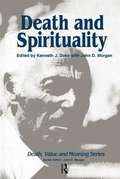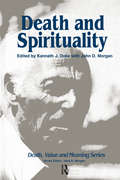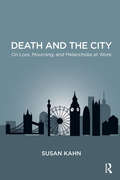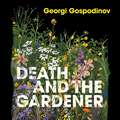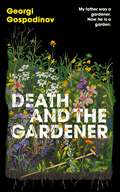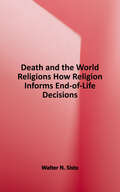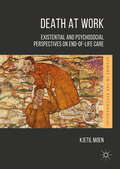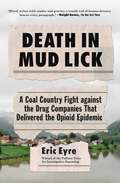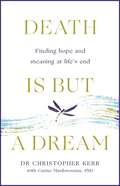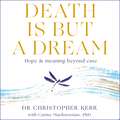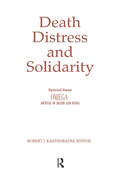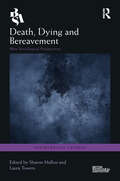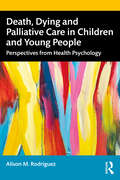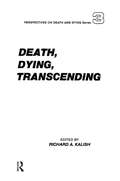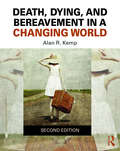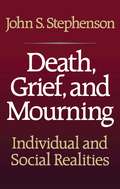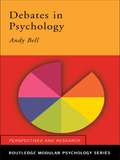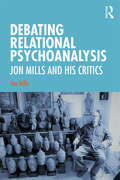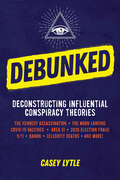- Table View
- List View
Death and Spirituality
by Kenneth J. Doka John D. MorganThis book specifically seeks to reach two, perhaps overlapping, audiences. First, it considers the needs of death-related counselors and educators, seeking to provide them with both a sense of the norm of religious tradition and the religious and spiritual issues that might arise in illness and bereavement, as well as suitable interventions, approaches and resources that might be useful in assisting clients in examining and resolving such issues. The book also speaks to the complementary needs of clergy who also may wish to assist parishioners and others as they face the spiritual and psychological crisis of dying and grief.
Death and Spirituality (Death, Value and Meaning Series)
by Kenneth J. Doka John D. MorganAn elderly Chinese immigrant, hospitalized with terminal disease, requests to burn incense. A 30-year-old Roman Catholic gay male, dying of AIDS, is consumed by deepening moral guilt, troubled by beliefs he thought he abandoned years ago. A mother whose teenage son died of an aneurism is angry at God over his death yet fearful of expressing that anger lest He 'punish her again.' A young widower seemingly has difficulty expressing grief believing it to be a sign of weak faith. All of these examples illustrate the kinds of issues that clinicians and counselors constantly encounter. For although North American society has long been characterized as secular, this does not deny the potency of spiritual concerns and religious values on the individual level. Polls affirm that vast majorities of North Americans both believe in God and consider religion important in their lives. This is clearly evident when one faces the crisis of dying or bereavement. For, one of the strengths of belief is that it provides support and succor at a time when secular explanations are largely silent. For these reasons, educators and clinicians have long recognized the significance that religious and spiritual themes have in counseling with the dying and bereaved. Yet, in cultures as religiously diverse as the U.S. and Canada, caregivers and educators may feel inadequate to the task. Death and Spirituality addresses this need. Specifically it seeks to reach two, perhaps overlapping, audiences. First, it considers the needs death-related counselors and educators, seeking to provide them with both a sense of the norm of religious tradition and the religious and spiritual issues that might arise in illness and bereavement, as well as suitable interventions, approaches, and resources that might be useful in assisting clients in examining and resolving such issues. The book also speaks to the complementary needs of clergy who also may wish to assist parishioners and others as they face the spiritual and psychological crisis of dying and grief.
Death and the American South
by Lorri Glover Craig Thompson FriendThis rich collection of original essays illuminates the causes and consequences of the South's defining experiences with death. Employing a wide range of perspectives, while concentrating on discrete episodes in the region's past, the authors explore topics from the seventeenth century to the present, from the death traps that emerged during colonization to the bloody backlash against emancipation and civil rights to recent canny efforts to commemorate - and capitalize on - the region's deadly past. Some authors capture their subjects in the most intimate of moments: killing and dying, grieving and remembering, and believing and despairing. Others uncover the intentional efforts of Southerners to publicly commemorate their losses through death rituals and memorialization campaigns. Together, these poignantly told Southern stories reveal profound truths about the past of a region marked by death and unable, perhaps unwilling, to escape the ghosts of its history.
Death and the City: On Loss, Mourning, and Melancholia at Work
by Susan KahnOrganisational collapse is part of our vernacular. Enron, Woolworths, Lehman's, Bank of America, Rover, BOAC, Northern Rock - these failures are part of our cultural experience of work. At a time when working lives are often vulnerable and organisational mortality is under threat from technology and the economy the consequences of organizational death are worthy of attention. Organisations can face many different endings - sharp and brutal, premature, or carefully planned and premeditated - all these endings have emotional collateral damage. We are working in an environment where crises, failure, and demise are everyday features. Death and the City provides an in-depth portrait of an organisation in a palliative state. It transports the analytic concepts of mourning and melancholia and of the death drive into the workplace, and brings this important, but under explored, stream of psychoanalytic thought to the fore as a means of interrogating and further understanding organisational life. .
Death and the Gardener
by Georgi GospodinovMy father was a gardener. Now he is a garden. A man sits by his father's bedside and reports radically and gently until a final winter morning.His father was one of that generation of tragic smokers born right after the World War II in Bulgaria, who clung to the snorkels of their cigarettes. A rebel without a cause, he knew how to fail with heroic self-deprecation.The garden he created out of a barren village yard first saved him, then killed him It remains his living legacy: peonies and potatoes, roses and cherry trees - and endless stories.But without him, his son's past, with all its afternoons, began to quietly crack. Because the end of our fathers is the end of a world.From the winner of the International Booker Prize, comes a novel about a father, a son, and an orphaned garden in a fading world that spans from ancient Ithaca to present-day Sofia, interweaving the botany of sorrow, the consolations of storytelling and the arrival of the first tulips of spring.
Death and the Gardener
by Georgi GospodinovMy father was a gardener. Now he is a garden. A man sits by his father's bedside and reports radically and gently until a final winter morning.His father was one of that generation of tragic smokers born right after the World War II in Bulgaria, who clung to the snorkels of their cigarettes. A rebel without a cause, he knew how to fail with heroic self-deprecation.The garden he created out of a barren village yard first saved him, then killed him It remains his living legacy: peonies and potatoes, roses and cherry trees - and endless stories.But without him, his son's past, with all its afternoons, began to quietly crack. Because the end of our fathers is the end of a world.From the winner of the International Booker Prize, comes a novel about a father, a son, and an orphaned garden in a fading world that spans from ancient Ithaca to present-day Sofia, interweaving the botany of sorrow, the consolations of storytelling and the arrival of the first tulips of spring.
Death and the World Religions: How Religion Informs End-of-life Decisions
by Walter N. SistoThis text has been written to provide healthcare professionals with a meaningful and succinct introduction to how religion informs end-of-life care. I am greatly indebted to my students at D'Youville College whose insights and challenging questions in the context of our course Challenges of Death prompted the writing of this text. Many of these students are healthcare majors who challenged me to explain how to care for patients of different religions from their own and the importance of religion for dying persons. In my search for a text that addressed this issue, I was surprised to discover that although a panoply of articles on effective healthcare for dying members of religious traditions exists, very few texts synthesize this scholarship for nonspecialists. This text synthesizes this material to provide my readers with an accessible introduction to important scholarship on this topic. - by Author
Death at Work: Existential and Psychosocial Perspectives on End-of-Life Care (Studies in the Psychosocial)
by Kjetil MoenThis book explores how, in encounters with the terminally ill and dying, there is something existentially at stake for the professional, not only the patient. It connects the professional and personal lives of the interviewees, a range of professionals working in palliative and intensive care. Kjetil Moen discusses how the inner and outer worlds, the psychic and the social, and the existential and the cultural, all inform professionals’ experience of work at the boundary between life and death. Death at Work is written for an academic audience, but is accessible to and offers insights for practitioners in a variety of fields.
Death in Mud Lick: A Coal Country Fight against the Drug Companies That Delivered the Opioid Epidemic
by Eric EyreFrom a Pulitzer Prize–winning reporter from the smallest newspaper ever to win the prize in the investigative reporting category, an urgent, riveting, and heartbreaking investigation into the corporate greed that pumped millions of pain pills into small Appalachian towns, decimating communities. <P><P>Death in Mud Lick is the story of a pharmacy in Kermit, West Virginia, that distributed 12 million opioid pain pills in three years to a town with a population of 382 people—and of one woman, desperate for justice, after losing her brother to overdose. Debbie Preece’s fight for accountability for her brother’s death took her well beyond the Sav-Rite Pharmacy in coal country, ultimately leading to three of the biggest drug wholesalers in the country. She was joined by a crusading lawyer and by local journalist, Eric Eyre, who uncovered a massive opioid pill-dumping scandal that shook the foundation of America’s largest drug companies—and won him a Pulitzer Prize. <P><P>Part Erin Brockovich, part Spotlight, Death in Mud Lick details the clandestine meetings with whistleblowers; a court fight to unseal filings that the drug distributors tried to keep hidden, a push to secure the DEA pill-shipment data, and the fallout after Eyre’s local paper, the Gazette-Mail, the smallest newspaper ever to win a Pulitzer Prize for investigative reporting, broke the story. Eyre follows the opioid shipments into individual counties, pharmacies, and homes in West Virginia and explains how thousands of Appalachians got hooked on prescription drugs—resulting in the highest overdose rates in the country. <P><P>But despite the tragedy, there is also hope as citizens banded together to create positive change—and won. A work of deep reporting and personal conviction, Eric Eyre’s intimate portrayal of a national public health crisis illuminates the shocking pattern of corporate greed and its repercussions for the citizens of West Virginia—and the nation—to this day.
Death is But a Dream: Hope and meaning at life's end
by Dr Christopher KerrThe first book to explore the meaningful dreams and visions that bring comfort as death nears. Experiences at the end of life testify to our greatest needs: to love and be loved, to be nurtured and feel connected, to be remembered and forgiven. Christopher Kerr is a hospice doctor. All of his patients die. Yet he has tended to thousands of patients who, in the face of death, speak of love, meaning and grace. They reveal that there is hope beyond cure as they transition to focus on personal meaning. In this extraordinary and beautiful book, Dr. Kerr shares his patients' stories and his own research pointing to death as not purely the end of life, but as a final passage of humanity and transcendence.Drawing on interviews with over 1,200 patients and more than a decade of quantified data , Dr. Kerr reveals why pre-death dreams and visions are remarkable events that bring comfort and exemplify human resilience. These are not regular dreams. Described as "more real than real," they frequently include loved ones long gone and mark the transition from distress to acceptance. These end-of-life experiences help patients restore meaning, make sense of the dying process and assist in reclaiming it as an experience in which they have a say. They also benefit the bereaved who get relief from seeing their loved ones pass with a sense of calm closure.Beautifully written with astonishing stories, this book, at its heart, celebrates the power to reclaim how we die, while soothing the bereaved who witness their loved ones go with unqualified grace.
Death is But a Dream: Hope and meaning at life's end
by Dr Christopher KerrChristopher Kerr is a hospice doctor. All of his patients die. Yet he has tended thousands of patients who, in the face of death, speak of love, meaning and grace. They reveal that there is hope beyond cure as they transition to focus on personal meaning. In this extraordinary and beautiful book, Dr. Kerr shares his patients' stories and his own research pointing to death as not purely the end of life, but as a final passage of humanity and transcendence.Drawing on interviews with over 1,200 patients and more than a decade of quantified data , Dr. Kerr reveals why pre-death dreams and visions are remarkable events that bring comfort and exemplify human resilience. These are not regular dreams. Described as "more real than real," they frequently include loved ones long gone and mark the transition from distress to acceptance. These end-of-life experiences help patients restore meaning, make sense of the dying process and assist in reclaiming it as an experience in which they have a say. They also benefit the bereaved who get relief from seeing their loved ones pass with a sense of calm closure.Beautifully written with astonishing stories, this book, at its heart, celebrates the power to reclaim how we die, while soothing the bereaved who witness their loved ones go with unqualified grace.(P)2020 Random House Audio
Death, Distress, and Solidarity: Special Issue "OMEGA Journal of Death and Dying"
by Robert KastenbaumIn preparing this special issue of "Omega: The Journal of Death and Dying" - we choose to consider solidarity in a somewhat larger perspective than the other one usually adopted by a clear majority of social support studies. This perspective gives priority to microscopic, immediate, direct transactions between a focal individual - the one affected by the prospect of soon to come death and two classes of people: those included in the core of that person's personal network and the health care personnel treating and accompanying soon to die people, many of them already advanced into agony.
Death, Dying and Bereavement: New Sociological Perspectives (Sociological Futures)
by Sharon Mallon Laura TowersWhile death, dying and bereavement are universal life events, the social conditions under which death takes place are fundamental in shaping how it is experienced by the individual. Bringing together contributors from around the world, this collection of chapters provides sociological insights into death, dying and bereavement.Drawing upon a range of sociological theorists, including Émile Durkheim, Zygmunt Bauman and C. Wright Mills, the book reviews the historical contribution of sociology to the field of thanatology. In doing so, the book challenges individualistic psychological approaches to death, dying and bereavement and demonstrates how sociological approaches can shape, constrain and empower experiences by imbuing them with both collective and individual meaning. Chapter-length case studies explore a wide range of issues, from digital aspects of remembrance and memorialisation and continued threats to liberties that permit life and death decisions to discussions of the impact and likely legacy of COVID-19 and climate change.This collection will be of interest to students and researchers in the social sciences with an interest in societal attitudes towards death and bereavement.
Death, Dying and Palliative Care in Children and Young People: Perspectives from Health Psychology
by Alison M. RodriguezDeath, Dying and Palliative Care in Children and Young People: Perspectives from Health Psychology examines the issues relevant to children and young people living with serious illness and their families by taking a closer look at the literature and knowledge around the processes of care, health, well-being and development through a health psychology lens. The text introduces readers to the general palliative and holistic care needs of children and young people along with the nuances of caring relationships. The chapters discuss the vulnerabilities encountered in living with serious illness and facing a shortened life prognosis, being at the end of life, and issues relative to the historical concept of the ‘good death’ or ‘dying well’, grief, and bereavement. The author examines how individual and familial experiences can be multi-layered, which can consequently influence perceptions and behaviours. The text therefore offers a deep exploration of the varied ways in which people draw on different resources to navigate their palliative care lived experiences. The book will be beneficial to the students of, and individuals interested in, psychology and nursing along with other health and social care courses. It will further be of interest to individuals interested in gaining more understanding of the experiential aspects of death, dying and palliative care in children and young people from health psychology perspectives.
Death, Dying, Transcending: Views from Many Cultures (Perspectives On Death And Dying Ser.)
by Richard A KalishEvery living thing must die, but only human beings know it. This knowledge can bring to the living, anxiety and despair or new richness and meaning. This volume explores the problems and possibilities of coping with this universal experience.
Death, Dying, and Bereavement in a Changing World (Second Edition)
by Alan R. Kemp<p>In this introductory text on thanatology, Alan Kemp continues the first edition’s trajectory of taking on the central question of mortality: the centrality of death coupled with the denial of death in the human experience. Drawing from the work of Ernest Becker, Death, Dying, and Bereavement in a Changing World provides a multidisciplinary and multidimensional approach to the study of death, putting extra emphasis on the how death takes place in a rapidly changing world. <p>This new, second edition includes the most up-to-date research, data, and figures related to death and dying. New research on the alternative death movement, natural disaster related deaths, and cannabis as a form of treatment for life-threatening illnesses, and updated research on physician assisted suicide, as well as on grief as it relates to the DSM-5 have been added.</p>
Death, Dying, and Bereavement: Contemporary Perspectives, Institutions, and Practices
by Judith M. Stillion Thomas AttigDelivers the collective wisdom of foremost scholars and practitioners in the death and dying movement from its inception to the present. Written by luminaries who have shaped the field, this capstone book distills the collective wisdom of foremost scholars and practitioners who together have nearly a millennium of experience in the death and dying movement. <p><p>The book bears witness to the evolution of the movement and presents the insights of its pioneers, eyewitnesses, and major contributors past and present. Its chapters address contemporary intellectual, institutional, and practice developments in thanatology: hospice and palliative care; funeral practice; death education; and caring of the dying, suicidal, bereaved, and traumatized. With a breadth and depth found in no other text on death, dying, and bereavement, the book disseminates the thinking of prominent authors William Worden, David Clark, Tony Walter, Robert Neimeyer, Charles Corr, Phyllis Silverman, Betty Davies, Therese A. Rando, Colin Murray Parkes, Kenneth Doka, Allan Kellehear, Sandra Bertman, Stephen Connor, Linda Goldman, Mary Vachon, and others. Their chapters discuss the most significant facets of early development, review important current work, and assess major challenges and hopes for the future in the areas of their expertise. <p><p>A substantial chronology of important milestones in the contemporary movement introduces the book, frames the chapters to follow, and provides guidance for further, in-depth reading. The book first focuses on the interdisciplinary intellectual achievements that have formed the foundation of the field of thanatology. The section on institutional innovations encompasses contributions in hospice and palliative care of the dying and their families; funeral service; and death education. The section on practices addresses approaches to counseling and providing support for individuals, families, and communities on issues related to dying, bereavement, suicide, trauma, disaster, and caregiving. An Afterword identifies challenges and looks toward future developments that promise to sustain, further enrich, and strengthen the movement. <p><p>KEY FEATURES: - Distills the wisdom of pioneers in and major contributors to the contemporary death, dying, and bereavement movement - Includes living witness accounts of the movement's evolution and important milestones - Presents the best contemporary thinking in thanatology -Describes contemporary institutional developments in hospice and palliative care, funeral practice, and death education -Illuminates best practices in care of the dying, suicidal, bereaved, and traumatized.
Death, Dying, and Grief: Theories, Tools, and Cases
by Douglas C. Smith Yan Z. CiupakThis book is a groundbreaking resource that explores loss through multidisciplinary and multicultural perspectives. Guided by the Spiral Model of Grieving and Healing, it honors the deeply personal yet socially embedded nature of dying and grieving. The book introduces the Integrative Psychosocial Model of Care, providing real-world cases, practical tools, and evidence-based insights from decades of teaching, research, training, and practice. While many books focus solely on academic theories or practical tools, few bridge the gap between them. This book uniquely combines thanatology theories with real-life cases and actionable tools, providing a comprehensive guide for end-of-life and grief support. It also maintains a compassionate and contemplative approach, incorporating diverse cultural viewpoints throughout. The book's 13 chapters are organized in five parts: Part I: An Integrative Understanding of Death, Dying, and Grief Part II: Theories and Concepts in Loss, Grief, and Dying Part III: Principles and Practices in End-of-Life and Grief Support Part IV: Supporting Psychosocial Needs in End-of-Life and Grieving <span lang="EN-IN" style="font-size: 12.0pt
Death, Dying, and Mysticism
by Thomas Cattoi Christopher M. MoremanThis volume offers a sample of reflections from scholars and practitioners on the theme of death and dying from scholars and practitioners, ranging from the Christian tradition to Hinduism, Lacanian psychoanalysis, while also touching on the themes of the afterlife and near-death experiences.
Death, Grief, and Mourning
by John S. StephensonHow do Americans cope with death? Do our feelings about dying influence the way we live? How are our ideas of death different from those of our ancestors? These questions and others are addressed in this innovative new book -- a comprehensive, interdisciplinary approach to the processes, practices, and experiences concerning death and dying in the United States. Drawing on sociology and psychology as well as history and literature, John S. Stephenson surveys the range of individual and social responses to death -- from our very conception of its meaning to the complex ethical dilemmas surrounding suicide and euthanasia. Stephenson synthesizes a theoretical perspective of death from the contributions of such important thinkers as Freud, Jung, Ernest Becker, and Robert Jay Lifton. He reviews the evolution of American attitudes and behaviors toward death -- from the Puritan era to the present, and charts the significance of such organizations for the dying as hospitals, hospices, and nursing homes. Bereavement as both personal reaction (grief) and social convention (mourning) is also discussed, as is the denial of death as a coping mechanism for individuals and institutions alike. In his final chapters, Stephenson analyzes the ceremonies of death (including gravestones as social indicators) and provides a psychosocial overview of suicide as a final, desperate attempt to assert control. He concludes by exploring the implications of euthanasia at a time when technology can extend life dramatically but is not always capable of assuring its quality. Throughout, authentic case examples -- many drawn from Stephenson's own clinical work -- illustrate the multi-faceted imagery and experiences that comprise the American way of death. Stephenson's book will be welcomed by sociologists, psychologists, social workers, religious leaders, nurses, and others concerned with caring for the dying and the bereaved. It is a brilliant and elegantly written work that crosses disciplinary boundaries to provide a valuable synthesis of existing knowledge and offer educators and professionals a firm foundation for teaching, practice, and research.
Debasing Political Rhetoric: Dissing Opponents, Journalists, and Minorities in Populist Leadership Communication (The Language of Politics)
by Ofer FeldmanThis book is a companion to Political Debasement: Incivility, Contempt, and Humiliation in Parliamentary and Public Discourse. It brings together interdisciplinary contributions to provide a comprehensive and detailed exploration of the nature, function, and effect of debasement language used by selected political leaders in Western and non-Western countries. Among them are Donald Trump (in the USA), Recep Tayyip Erdoğan (Turkey), Rodrigo Roa Duterte (Philippines), Jair Bolsonaro (Brazil), Abe Shinzô (Japan), Pauline Hanson (Australia), Kyriakos Mitsotakis (Greece), Geert Wilders (the Netherlands), Beppe Grillo (Italy), and Santiago Abascal (Spain). Chapters focus specifically on the language of these leaders while examining debasement discourse from narrow and broad perspectives. The former includes the use of crude or abusive language (e.g., curses, obscenity, and swearing) to demean, humiliate, mock, insult, or belittle, based on the actual or perceived object or entity (e.g., race, religion, national, gender identity, or sexual orientation); the latter includes the use of devious or indirect irony, sarcasm, cynicism, ridicule, subtlety, and understatement to degrade and discredit other individuals or groups. The book represents the collective wisdom of scholars and researchers, experts in fields such as communication, political science, international relations, and social and political psychology. Cumulatively, the authors develop a global analysis of debasement discourse in societies from West to East and offer a cutting-edge approach to expand a framework assessing the role and effect of such rhetoric in contemporary politics.
Debates in Psychology (Routledge Modular Psychology)
by Andy BellDebates in Psychology tackles some of the major issues and controversies within the field of psychology. The book includes a discussion of the major debates in psychology prescribed by the AQA Specification A-Level syllabus, such as free will and determinism, whether or not psychology can (or indeed should) be a science, reductionism, and the nature-nurture debate. Additionally, the 'mind-body question' is examined as an example of reductionism in psychology. A chapter on behaviourism is also included in order to draw together the debates covered throughout the book.Each topic covered in Debates in Psychology is presented in a highly readable and accessible manner. The book will be invaluable for students wishing to gain a greater understanding of this exciting area.
Debating Relational Psychoanalysis: Jon Mills and his Critics
by Jon MillsIn Debating Relational Psychoanalysis, Jon Mills provides an historical record of the debates that had taken place for nearly two decades on his critique of the relational school, including responses from his critics. Since he initiated his critique, relational psychoanalysis has become an international phenomenon with proponents worldwide. This book hopes that further dialogue may not only lead to conciliation, but more optimistically, that relational theory may be inspired to improve upon its theoretical edifice, both conceptually and clinically, as well as develop technical parameters to praxis that help guide and train new clinicians to sharpen their own theoretical orientation and therapeutic efficacy. Because of the public exchanges in writing and at professional symposiums, these debates have historical significance in the development of the psychoanalytic movement as a whole simply due to their contentiousness and proclivity to question cherished assumptions, both old and new. In presenting this collection of his work, and those responses of his critics, Mills argues that psychoanalysis may only advance through critique and creative refinement, and this requires a deconstructive praxis within the relational school itself. Debating Relational Psychoanalysis will be of interest to psychoanalysts of all orientations, psychotherapists, mental health workers, psychoanalytic historians, philosophical psychologists, and the broad disciplines of humanistic, phenomenological, existential, and analytical psychology.
Debating Self-Knowledge
by Gary Ebbs Anthony BruecknerLanguage users ordinarily suppose that they know what thoughts their own utterances express. We can call this supposed knowledge minimal self-knowledge. But what does it come to? And do we actually have it? Anti-individualism implies that the thoughts which a person's utterances express are partly determined by facts about their social and physical environments. If anti-individualism is true, then there are some apparently coherent sceptical hypotheses that conflict with our supposition that we have minimal self-knowledge. In this book, Anthony Brueckner and Gary Ebbs debate how to characterize this problem and develop opposing views of what it shows. Their discussion is the only sustained, in-depth debate about anti-individualism, scepticism and knowledge of one's own thoughts, and will interest both scholars and graduate students in philosophy of language, philosophy of mind and epistemology.
Debunked EBK: Separate the Rational from the Irrational in Influential Conspiracy Theories
by Casey LytleHead down the rabbit hole and feed your fascination for conspiracy and controversy. Conspiracy theories-they're influential and spread to sometimes irrational extremes. Why do people cling to conspiracy theories so powerfully? Is there a way to separate the possible from the impossible? Yes. Enter: Debunked.Conspiracy theories pop up surrounding every major national and global event-some are possible, some are not. TikTok influencer and psychology professor Casey Lytle will teach you how to be an intelligent consumer of "alternative" theories. Lytle's trademark "project management approach" will help you discern possible from impossible in the popular and controversial theories surrounding 10 national and global events.9/11-No fewer than 10 alternative theories have gained traction. But let's evaluate: Did the Twin Towers really look like a controlled demolition? Would jet fuel have to melt steel for the towers to collapse? What would it take in hours and people to secretly plant enough explosives to bring the buildings down without being discovered, and without being set off by the impact and fires from the planes? All this and more in Chapter 7.COVID-19-The vaccine implants a microchip used to track people; the fatality rate has been wildly inflated; oh, and Bill Gates is not only responsible for the virus but also the head of a plot to use the virus as population control.School shooters-why are they so easy to explain, but so hard to predict? In what ways has the profile of a school shooter changed over the last 25 years, and what has caused those changes? Are school shootings a new phenomenon, or does the media simply make us more aware of them when they happen? The chapter will cover Sandy Hook conspiracy theories, as well as the psychology behind "truthers."
